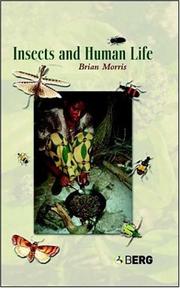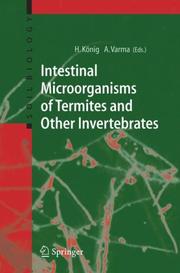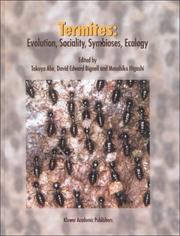| Listing 1 - 9 of 9 |
Sort by
|
Book
ISBN: 0621149896 9780621149890 Year: 1994 Publisher: Pretoria, Republic of South Africa Dept. of Agriculture
Abstract | Keywords | Export | Availability | Bookmark
 Loading...
Loading...Choose an application
- Reference Manager
- EndNote
- RefWorks (Direct export to RefWorks)
Lepidotermes --- Termitidae --- Termites
Book
Year: 1992 Publisher: Firenze : Istituto Agronomico per l'Oltremare,
Abstract | Keywords | Export | Availability | Bookmark
 Loading...
Loading...Choose an application
- Reference Manager
- EndNote
- RefWorks (Direct export to RefWorks)
Isoptera --- Isoptera --- Termitidae --- Termitidae --- Entomology --- Entomology --- 1778-1991 --- 1778-1991
Book
Abstract | Keywords | Export | Availability | Bookmark
 Loading...
Loading...Choose an application
- Reference Manager
- EndNote
- RefWorks (Direct export to RefWorks)
Termitidae --- Termitidae --- Cultivation --- Cultivation --- soil types --- soil types --- Kenya --- Kenya
Dissertation
Year: 1984 Publisher: Wageningen : Agricultural University, Department of Soil Science and Geology,
Abstract | Keywords | Export | Availability | Bookmark
 Loading...
Loading...Choose an application
- Reference Manager
- EndNote
- RefWorks (Direct export to RefWorks)
soil genesis --- Volcanic soils --- Termitidae --- Cendre volcanique --- Wageningen --- Kenya --- Cendre volcanique --- Wageningen
Dissertation

Year: 2017 Publisher: Liège Université de Liège (ULiège)
Abstract | Keywords | Export | Availability | Bookmark
 Loading...
Loading...Choose an application
- Reference Manager
- EndNote
- RefWorks (Direct export to RefWorks)
The soils of different agrosystems are studied simultaneously with termite activity in the context of long-term restoration project. The aim is to highlight the positive impact of termites on soil physicochemical properties. Previous studies have mainly focused on permanent structures built by those insects such as mounds, punctually impacting the landscape. In order to study a more widespread impact of termites, the temporary structures built for food foraging are compared to the underlying soil. It is assumed that, after rainfall or watering, these structures will return to the soil surface. The three sites are a fallow land (permanent pasture), a tilled field and agroecological raised beds. Termites only show up where there is organic matter, irrespective of its type. In the three sites, clay content, available K, Mg and P, organic carbon, pH, cation exchange capacity (except in the fallow) and exchangeable bases are increased in the biogenic constructions. The increase is generally lower in the beds because the reference soil already has higher values. In the field and the fallow, the aggregation is improved in termite sheetings, as the macroaggregates in both sites and the protected microaggregates in the field increase whereas the free microaggregates decrease. In the beds, the reference soil already has a better physical stability, with more macroaggregates and protected microaggregates. Our results demonstrate that agricultural conservation practices are able to improve most of the soil properties in the same way that for ecosystem engineers such as termites.
Dissertation
Year: 1988 Publisher: Campinas (Sâo Paulo) : UNICAMP,
Abstract | Keywords | Export | Availability | Bookmark
 Loading...
Loading...Choose an application
- Reference Manager
- EndNote
- RefWorks (Direct export to RefWorks)
Swamps --- Flooded land --- Termitidae --- vegetation. --- vegetation --- Savannas --- Prairies --- Termitiere --- Campinas --- Anglais --- Portugais --- Brazil --- Mato Grosso --- Termitiere --- Campinas --- Anglais --- Portugais

ISBN: 1859738478 1845200756 9781859738474 9781845209490 1845209494 9781474214957 1474214959 9781845200756 1282545523 9781282545526 9786612545528 6612545526 9781000189810 1000189813 9781003085713 1003085717 1000183181 9781000186697 1000186695 9781000183184 Year: 2004 Publisher: Oxford ; New York : Berg,
Abstract | Keywords | Export | Availability | Bookmark
 Loading...
Loading...Choose an application
- Reference Manager
- EndNote
- RefWorks (Direct export to RefWorks)
This pioneering book looks at the importance of insects to culture. While in the developed West a good deal of time and money may be spent trying to exterminate insects, in other cultures human-insect relations can be far more subtle and multi-faceted. Like animals, insects may be revered or reviled - and in some tribal communities insects may be the only source of food available. How people respond to, make use of, and relate to insects speaks volumes about their culture. In an effort to get to the bottom of our vexed relationship with the insect world, Brian Morris spent years in Malawi, a country where insects proliferate and people contend. In Malawi as in many tropical regions, insects have a profound impact on agriculture, the household, disease and medicine, and hence on oral literature, music, art, folklore, recreation and religion. Much of the complexity of human-insect relations rests on paradox: insects may represent the source of contagion, but they are also integral to many folk remedies for a wide range of illnesses. They may be at the root of catastrophic crop failure, but they can also be a form of sustenance.Weaving science with personal observations, Morris demonstrates a profound and intimate knowledge of virtually every aspect of human-insect relations. Not only is this book extraordinarily useful in terms of the more practical side of entomology, it also provides a wealth of information on the role of insects in cultural production. Malawian proverbs alone provide many such delightful examples - 'Bemberezi adziwa nyumba yake' ('The carpenter bee knows his own home'). This final volume in Morris' trilogy on Malawi's animal and insect worlds is certain to become a classic study of uncharted territory - the insect world that surrounds us and how we relate to it. Praise for The Power of Animals:Although based upon examination of a single culture, Morris incorporates ecological and anthropological concepts that expand this study of
Entomology --- Biodiversity --- Useful insects --- Food resources --- Human feeding --- Apiculture --- apiculture --- Stored products pests --- pests of plants --- Forest pests --- Vectors --- Social anthropology --- Heteroptera --- Apidae --- Termitidae --- Acrididae --- Noctuidae --- Formicidae --- Beneficial insects --- Insect pests --- Malawi --- Africa --- apiculture. --- Insects --- Hexapoda --- Insecta --- Pterygota --- Arthropoda --- Destructive insects --- Economic entomology --- Entomology, Economic --- Injurious insects --- Insects, Injurious and beneficial --- Arthropod pests --- Veterinary entomology --- Insects, Beneficial --- Zoology, Economic --- Ecology

ISBN: 3540281800 9783540281801 3642066380 9786610413089 1280413085 3540281851 Year: 2006 Volume: 6 Publisher: Berlin ; New York : Springer,
Abstract | Keywords | Export | Availability | Bookmark
 Loading...
Loading...Choose an application
- Reference Manager
- EndNote
- RefWorks (Direct export to RefWorks)
Soil microorganisms play a major role in the degradation and recycling of organic material. Microbes are involved in the food web and strongly contribute to soil fertility. In the past, attention was mainly directed towards free-living or particle-bound microorganisms, while the role of intestinal microbes of soil animals has been neglected. For the first time, "Intestinal Microorganisms of Termites and Other Invertebrates" focuses on the microbes in gut systems of soil animals. It starts with a profound overview of the biology of soil invertebrates. A major part deals with the gut microbiota of termites, the best investigated gut system of invertebrates. Termites are important soil processors in tropical and subtropical regions. Insight is given into the intestinal microbiota of further relevant primary litter decomposers, such as earthworms, springtails, millipeds, and woodlice. Novel techniques for studying intestinal microbes complete the volume.
Soil invertebrates --- Intestines --- Termites --- Invertébrés du sol --- Intestins --- Microbiology --- Microbiologie --- Invertébré --- Invertebrates --- Flore microbienne --- microbial flora --- Intestin --- intestines --- Flore du sol --- Soil flora --- Symbiose --- Symbiosis --- Termitidae --- Fonction physiologique --- physiological functions --- Biologie du sol --- Soil biology --- Pédogénèse --- soil genesis --- Soil invertebrates. --- Zoology --- Biology --- Health & Biological Sciences --- Microbiology & Immunology --- Invertebrates & Protozoa --- Microbiology. --- Invertébrés du sol --- EPUB-LIV-FT LIVBIOLO SPRINGER-B --- Dictyoptera --- Isoptera --- White ants --- Mesofauna --- Bacteriology --- Life sciences. --- Ecology. --- Animal physiology. --- Invertebrates. --- Soil science. --- Soil conservation. --- Life Sciences. --- Terrestial Ecology. --- Animal Physiology. --- Soil Science & Conservation. --- Insects --- Termitomyces --- Soil animals --- Conservation of soil --- Erosion control, Soil --- Soil erosion --- Soil erosion control --- Soils --- Agricultural conservation --- Soil management --- Animal physiology --- Animals --- Anatomy --- Balance of nature --- Bionomics --- Ecological processes --- Ecological science --- Ecological sciences --- Environment --- Environmental biology --- Oecology --- Environmental sciences --- Population biology --- Invertebrata --- Microbial biology --- Microorganisms --- Control --- Prevention --- Conservation --- Physiology --- Ecology --- Ecology . --- Pedology (Soil science) --- Agriculture --- Earth sciences --- Physiology. --- Experimental Organisms. --- Soil Science. --- Technique.

ISBN: 0792363612 9048154766 940173223X Year: 2000 Publisher: Dordrecht Boston London : Kluwer Academic Publishers,
Abstract | Keywords | Export | Availability | Bookmark
 Loading...
Loading...Choose an application
- Reference Manager
- EndNote
- RefWorks (Direct export to RefWorks)
The book is a new compendium in which leading termite scientists review the advances of the last 30 years in our understanding of phylogeny, fossil records, relationships with cockroaches, social evolution, nesting, behaviour, mutualisms with archaea, protists, bacteria and fungi, nutrition, energy metabolism,population and community ecology, soil conditioning, greenhouse gas production and pest status.
595.732 --- 591.55 --- 591.55 Communal life. Animal societies --- Communal life. Animal societies --- 595.732 Corrodentia. Termites. Woodlice. Booklouse --- Corrodentia. Termites. Woodlice. Booklouse --- Termitidae --- Structure de la population --- social behaviour --- Compétition biologique --- Comportement alimentaire --- Termites --- Dictyoptera --- Isoptera --- White ants --- Insects --- Termitomyces --- Identification --- identification --- population structure --- population dynamics --- Biological competition --- Feeding habits --- identification. --- Animal systematics. --- Animal taxonomy. --- Evolutionary biology. --- Soil science. --- Soil conservation. --- Climate change. --- Microbial ecology. --- Invertebrates. --- Animal Systematics/Taxonomy/Biogeography. --- Evolutionary Biology. --- Soil Science & Conservation. --- Climate Change. --- Microbial Ecology. --- Invertebrata --- Animals --- Environmental microbiology --- Microorganisms --- Ecology --- Microbiology --- Changes, Climatic --- Changes in climate --- Climate change --- Climate change science --- Climate changes --- Climate variations --- Climatic change --- Climatic changes --- Climatic fluctuations --- Climatic variations --- Global climate changes --- Global climatic changes --- Climatology --- Climate change mitigation --- Teleconnections (Climatology) --- Conservation of soil --- Erosion control, Soil --- Soil erosion --- Soil erosion control --- Soils --- Agricultural conservation --- Soil management --- Pedology (Soil science) --- Agriculture --- Earth sciences --- Animal evolution --- Biological evolution --- Darwinism --- Evolutionary biology --- Evolutionary science --- Origin of species --- Biology --- Evolution --- Biological fitness --- Homoplasy --- Natural selection --- Phylogeny --- Animal classification --- Animal systematics --- Animal taxonomy --- Classification --- Systematic zoology --- Systematics (Zoology) --- Taxonomy, Animal --- Zoological classification --- Zoological systematics --- Zoological taxonomy --- Zoology --- Environmental aspects --- Control --- Prevention --- Conservation
| Listing 1 - 9 of 9 |
Sort by
|

 Search
Search Feedback
Feedback About UniCat
About UniCat  Help
Help News
News